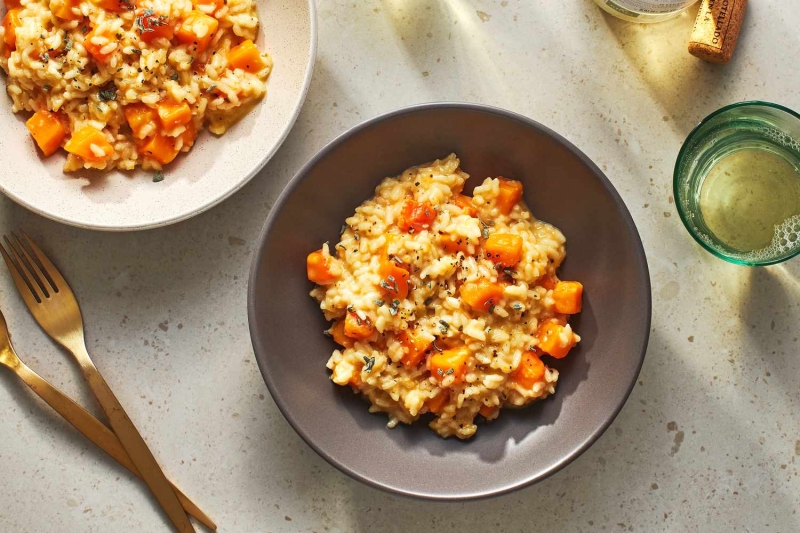Prep: 15 mins
Cook: 50 mins
Total: 65 mins
Servings: 4 servings
Yield: 4 cups
When I think of risotto, words such as rich, creamy, and satisfying come to mind. The thought of risotto conjures up images of a steamy and aromatic bowl of rice that is perfect on its own but equally good accompanied by other vegetables or sources of protein. But what exactly is risotto?
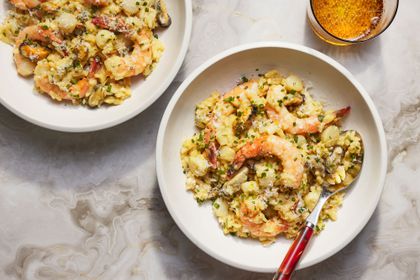
What Is Risotto?
Risotto is Italian rice dish with arborio rice as the base, and various other vegetables and flavorings incorporated. Arborio rice is a variety of short-grain white rice that is named after the region of Italy where it was originally cultivated. It is naturally high in starch, which serves an important function in creating the distinctive, creamy texture of this dish.
The addition of butternut squash to risotto offers satisfying and playful sweet and savory flavors. While most of the squash pieces will maintain their texture, some of the squash will naturally break down. The end result is a brightly-colored dish that is exceptionally creamy.
What To Serve With Risotto
Risotto can be served as a main course, alongside a salad such as this refreshing citrus salad, or to accompany a protein. Roasted chicken, grilled steaks, pan-seared scallops, and shrimp are perfect accompaniments to risotto, but be sure to moderate the quantity unless you’re really hungry! Cooked chickpeas or fresh fava beans offer a great vegetarian protein alternative
Tips for Making Risotto
Be Patient
One key feature of a properly cooked risotto is patience, meaning that this is definitely not a dish to make when you are in a hurry or impatient. A typical risotto preparation will take at least 45 minutes and requires your attention for the duration of the cooking process. Cooking risotto is a great counterbalance to our fast-paced world: an opportunity to slow down, be mindful, and be in awe of how these tiny hard grains are transformed into something so soft, creamy, and inviting.
Use Hot Broth
Risotto is cooked slowly and in stages, with the addition of small amounts of hot broth to create the much desired creamy texture. Using hot broth expedites the cooking process and allows for the rice to cook properly and more efficiently.
Don't Forget To Stir— But Not Too Much
It may be hard to believe, but the key technique used to develop the signature creamy texture of risotto is the simple stir! Stirring allows the rice grains to rub against each other and release some of the natural starch back into the dish.
While it is absolutely necessary to stir frequently, it is equally important not to over-stir. Over-stirring could result in too much starch being released into the dish, resulting in a porridge-y consistency. As a general rule, stirring every 30 seconds allows the rice to release the right amount of starch while preventing the rice from sticking to the bottom of the pot.
It's one of those comforting and warming fall dishes that requires little effort but offers so much in return! The sweet and tender butternut squash makes a great team with the salty parmesan cheese. The sage took this creamy risotto to another level and added another layer of flavor." —Diana Chistruga
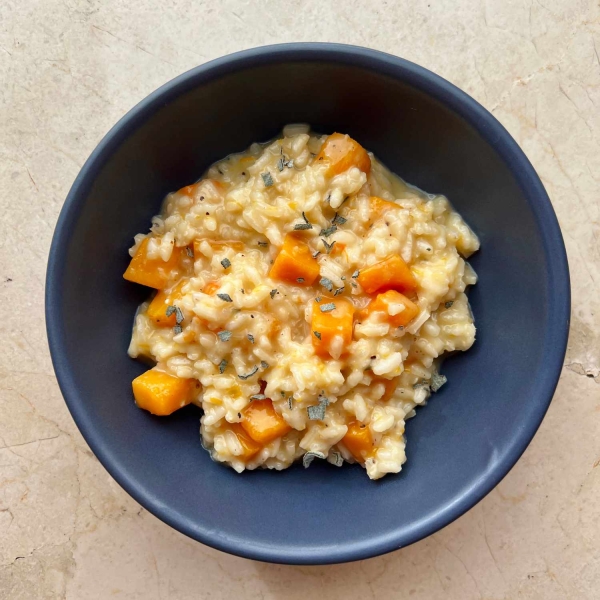
A Note From Our Recipe Tester
Ingredients
-
4 1/2 cups low-sodium vegetable broth or chicken broth
-
1 medium butternut squash, about 1 pound
-
1 1/2 tablespoons olive oil
-
2 large shallots, minced (about 1/2 cup) shallots
-
2 cloves garlic, minced
-
1 teaspoon minced fresh sage leaves, divided
-
1 cup arborio rice
-
1/2 cup dry white wine
-
1/2 teaspoon fine salt, plus more to taste
-
1/4 teaspoon freshly ground black pepper
-
2 tablespoons unsalted butter
-
1/2 cup freshly grated parmesan cheese
Steps to Make It
-
Gather the ingredients.
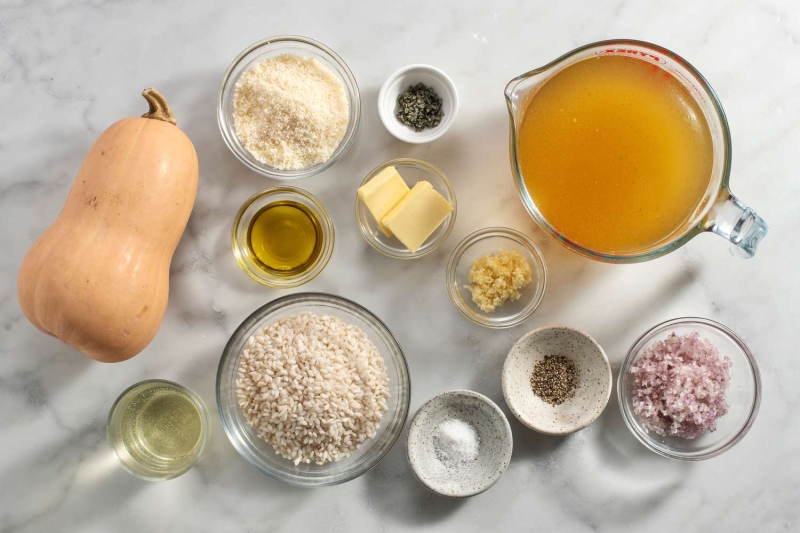
-
Heat the broth in a medium saucepan on medium heat until it simmers. Reduce the heat to low, cover and continue to simmer.
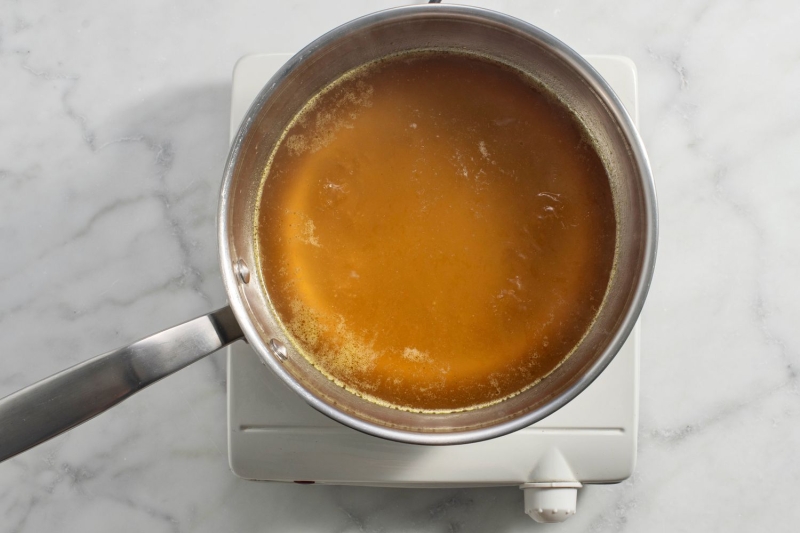
-
Meanwhile, using a sharp, heavy chef’s knife, cut off both ends of the squash. Peel the squash using a vegetable peeler, scoop out the seeds, and cut the squash into 1/2 inch cubes.

-
Heat the oil in a Dutch oven or other heavy-duty pot on medium heat. When the oil shimmers, add the shallots and sauté until translucent and aromatic, about 2 minutes.
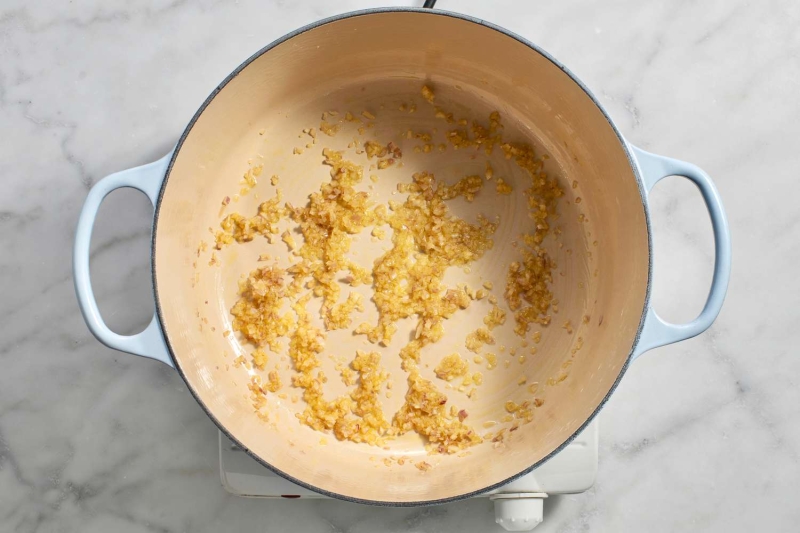
-
Add the garlic, 1/2 teaspoon of minced sage leaves, and diced squash. Continue to sauté on medium heat for 6 to 8 more minutes, stirring occasionally.
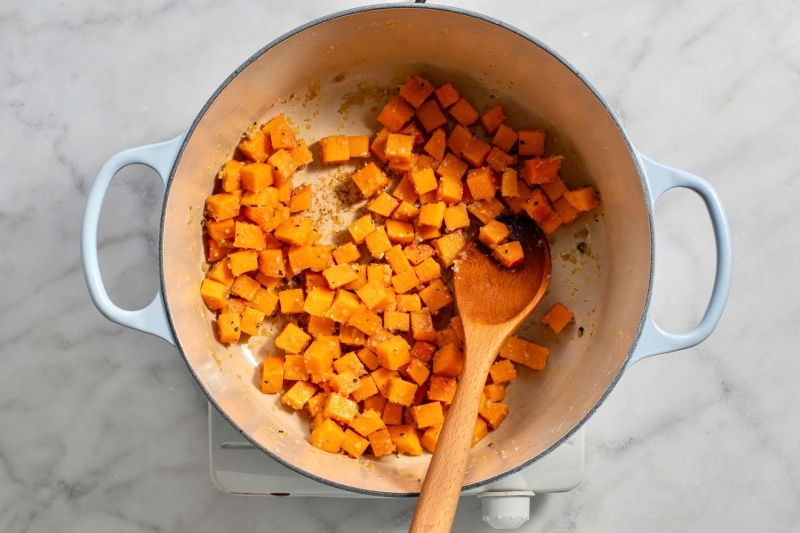
-
Add the rice, stirring frequently, until the rice is lightly toasted, 1 to 2 minutes.
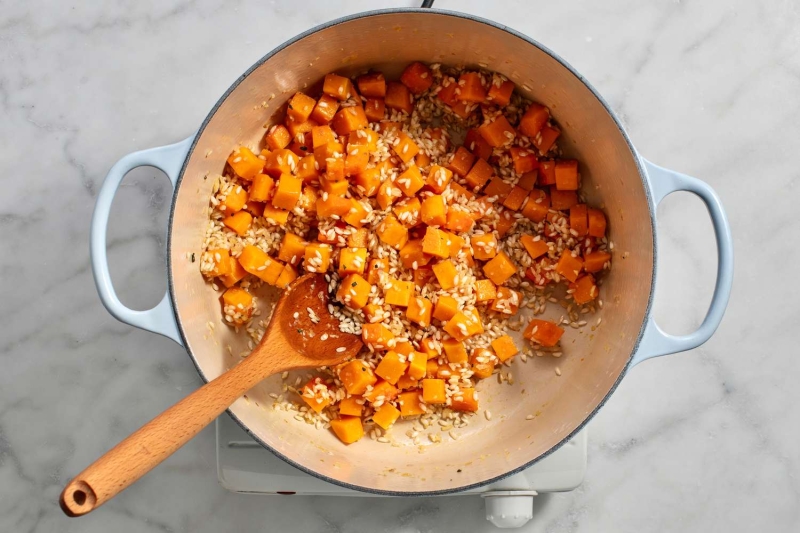
-
Add the wine and cook over medium heat, stirring frequently, until the wine is absorbed into the squash and rice mixture, about 3 minutes.
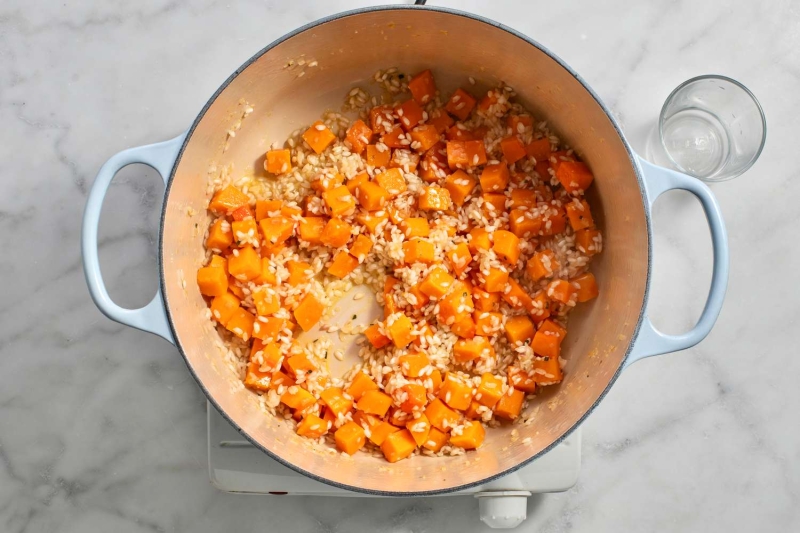
-
Reduce the heat to medium-low. Add salt, pepper, and 1/2 cup of the vegetable broth, stirring every 30 seconds, until the broth is absorbed into the rice. Continue by adding 1/2 cup of broth at a time, again stirring every 30 seconds, until the broth has been absorbed. This step should take about 45 to 50 minutes, until the squash is soft and creamy and the rice cooked through, but still al dente.
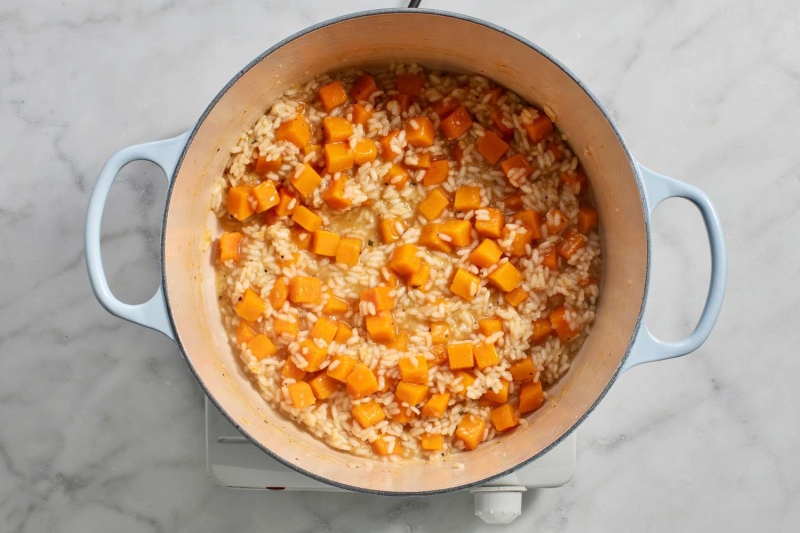
-
Remove the risotto from the heat, and stir in the butter and Parmesan cheese.
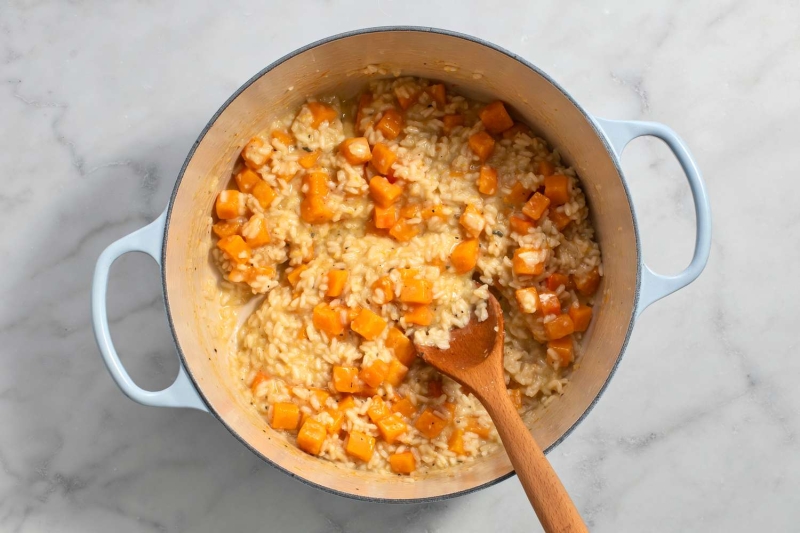
-
Garnish with the remaining 1/2 teaspoon of minced sage leaves and serve hot.
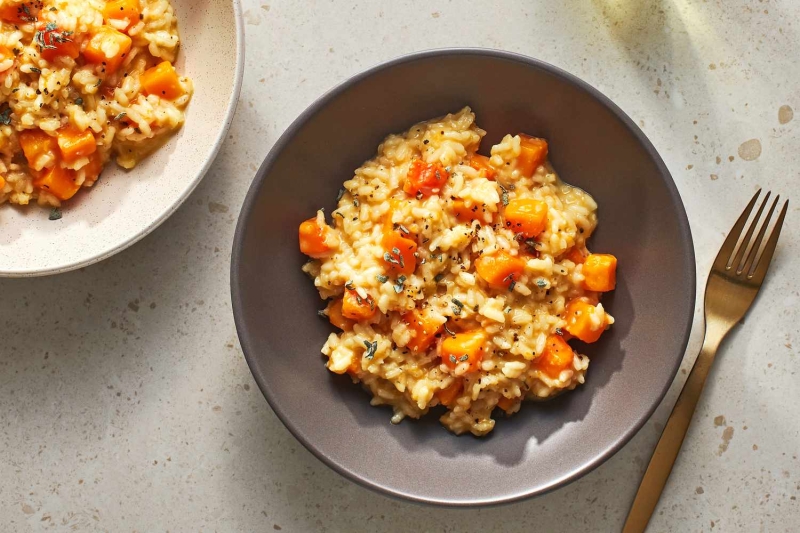
Recipe Tips
- Wine can be eliminated and replaced by more broth or water.
- While store-bought vegetable or chicken broth is convenient, home-prepared broth can add that extra depth to the dish.
- The freshly grated Parmesan or Pecorino Romano that is added at the very end should be of the best quality, offering a special salty and nutty flavor and adding extra creaminess.
- Risotto will thicken as it sits, so it is best served immediately after preparation.
Variations
- Risotto is highly versatile and can be prepared plain on its own or mixed with a medley of other vegetables such as asparagus, sweet potatoes, delicata squash, mushrooms, peas, or fava beans.
- Explore additional flavorings such as saffron, thyme, rosemary, parsley, or lemon zest to liven up the risotto. A handful of lightly toasted nuts can also add a special crunch to contrast with the creamy risotto. If you are feeling creative, consider topping the dish with fried sage leaves or crispy fried shallots.
How To Store
Store leftover risotto in an airtight container in the refrigerator for up to 4 days or in the freezer for up to 1 month. Reheat in a skillet over medium-low heat, adding a small amount of broth or water to help with rehydration and bring some creaminess back to the dish.
| Nutrition Facts | |
|---|---|
| Servings: 4 | |
| Amount per serving | |
| Calories | 310 |
| % Daily Value* | |
| Total Fat 15g | 19% |
| Saturated Fat 6g | 32% |
| Cholesterol 26mg | 9% |
| Sodium 1249mg | 54% |
| Total Carbohydrate 34g | 12% |
| Dietary Fiber 4g | 15% |
| Total Sugars 6g | |
| Protein 7g | |
| Vitamin C 20mg | 101% |
| Calcium 177mg | 14% |
| Iron 2mg | 11% |
| Potassium 504mg | 11% |
| *The % Daily Value (DV) tells you how much a nutrient in a food serving contributes to a daily diet. 2,000 calories a day is used for general nutrition advice. | |
